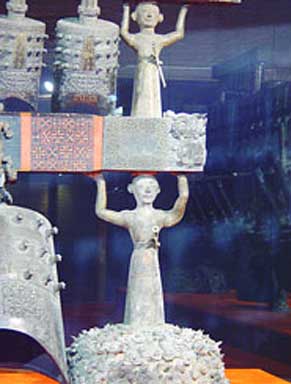| Legole.Com Discover china. Explore the beauty and wonder of the land, people, and culture of China. |
 |
|
|
 |
 The Hubei Provincial Museum established in 1953 contains the most important collections of artifacts in the province. More than 140,000 items, mainly from a big tomb excavated in 1978, are well preserved here, including 645 first class cultural relics and 16 national treasures. The Hubei Provincial Museum established in 1953 contains the most important collections of artifacts in the province. More than 140,000 items, mainly from a big tomb excavated in 1978, are well preserved here, including 645 first class cultural relics and 16 national treasures.
In the summer of 1978, Hubei Provincial archaeologists working near Cheng Guan (present-day Suizhou) in Sui County excavated a huge tomb more than 2,400 years old. Dating from around 433 BC, the tomb was that of Marquis Yi of the state of Zeng. Zeng was one of the hosts of lesser states during the Warring States Period (475-221 B.C.). More than 15,000 relics were excavated from the tomb, including the bronze ritual vessels, coffins, musical instruments, gold and jade decorative items, lacquer ware, weapons, inscribed bamboo strips and other relics.
Musical Instruments
There are eight kinds and 125 pieces of musical instruments excavated from the tomb, including bells, stone chimes, and drums, Se, Zithers, Sheng, Panpipe and Chi, of which the chime bell is most famous.
As the heaviest musical instrument in the world, this set of chime bells, with a total weight of 2,500 kilogram, consists of 65 pieces - the biggest bell is 152cm high and 204kg and the smallest 20cm long and 3kg . They were suspended on three ordered fames and divided into eight groups. The Niu Bell on the upper layer, 19 pieces, were used to producing clear tones, thirty-three pieces of Yong Bell on the middle layer for melody and twelve pieces of Yong Bell on the lower layer for accompanying. Each bell can produce two different tones when struck. The chime bells covered roughly five and half octaves and entire 12 semitones, which were most like current C major.
Gold inscriptions of 3,755 words were carved on the body, the frame and hung hooks recording the order of bells, events, notes and records of note names, scale names, octaves and musical pitch connection between other states.
The implements used in play the bells that were unearthed were six pieces of T-shaped wooden poles painted in colors and two colorful wooden sticks. According to related materials, there were probably five performers involved in the playing of the bells, with two standing in front of the set playing the larger bells with long poles and three behind playing the smaller bells with smaller sticks.
This set of chime bell of Marquis Yi of Zeng reflected achievements in multiple fields: music, study of musical pitch, acoustics and metallurgy. It is one of the major archaeological discoveries in the 20th century.
Bronzes
Altogether 6,239 pieces of bronzes were excavated from the tomb, including 117 pieces of ritual vessels and 17 pieces of utensils. Among these, bronze Zun and Pan are worthy of notice. It consists of two individual vessels - Zun and Pan. The Zun is used as a wine receiver and the Pan is used to hold the Zun. The two vessels are formed into a whole. Four symmetrical dragon-shaped legs are attached to the bottom of the Pan. Four symmetrical hollowed-out handless cubes are adhered to the edge of the pan's mouth. There are hollowed-out additional ornaments stuck to the lower parts on each side of the handles. Four crawling beasts are climbing upwards and throwing up their tongues on the neck of the Zun. The bronze Zun and Pan are exquisite and the ornaments are complicated, reputed as the best model of China's bronze ware in ancient times.
Lacquer Ware
The lacquer wares excavated include tableware and wine vessels for picnics, boxes, cups, buckets, suitcases for food and other things. This batch of lacquer ware is both practical and elegant and most of the models are delicately designed according to function. The lacquer ware is colorful and richly ornamented. A suitcase cover was painted with pictures of astronomical phenomena, which indicates that ancient Chinese had already noticed the movements of stars and mastered the law of the four season's changing. Both ends of the cover were also engraved with dragons and tigers.
Although the museum is small, its collection is rich and various, which attract more and more appreciative visitors from both home and abroad.
Admission Fee: 30 |
 |
|
|
 |
|
